The use of electric vehicles is no longer limited, and already their share is 25% of new sales in the global automotive market. In the USA, most owners choose to install a charger in their homes, which makes the use of EVs even more convenient. But some difficulties come when a family owns two electric cars—it is likely that there is often a need to charge two cars at the same time.
Read this article to find out more about some ways to charge two electric cars at home. We will analyze the advantages, disadvantages and relevance of each method so you can determine which one will be best in your case. We also will take a look at the best EV chargers in North America.
You can charge two EVs at once by using one of the following methods:
- Buy a dual charging station
- Install two chargers to one circuit
- Purchase a charger for each vehicle and connect them to separate circuit breakers
- Install a Level–2 charging station and use a Level–1 charger supplied with the EV
Now let’s go over each option in more detail.
Here are several of the best models of EV dual chargers:
- Ideal for 2 EVsGrizzl-E Duo Level 2 Dual EV Charger (240 Volt, 24ft Cable, 40 Amp) NEMA 14-50 Plug, ideal for two electric cars$79900Prime
eligibleJul 9, 2025 6:15 AM - Get a great dealJul 9, 2025 6:15 AM
EV Adept’s customers who own two electric automobiles frequently purchase the following charging equipment:
- ClipperCreek HCS-40 Dual. This Level–2 station can be installed into a single 40-amp circuit.
Where to buy? Amazon or ClipperCreek’s site - Grizzl-E Duo. The device provides up to 10 kW of power to one electric car and features dynamic power-sharing.
Where to buy? Amazon or Grizzl-E’s site - EV40D Dual EV Charger. The station splits up to 16 amps of electricity for each electric vehicle.Where to buy? Manufacturer’s website
Option 1: Dual Charging Station
If your family has two electric cars, then one of the best options for simultaneous charging would be to get a dual charging station1. It is hooked up to a single circuit and comes with two cables and two chargers in a one box. Installing this kind of device could expand the capacity of a limited electrical setup without investing more in a new circuit or service panel, which allows for additional charging of electric vehicles.

A dual charger is a Level–2 hard-wired device that splits electricity between two cars, so while charging, each car gets half the power2. This option is great if you charge cars overnight, as both can be fully charged in that time. If you charge only one car, then 20–30 miles of range will be added per hour.
When selecting a dual charger, you need to remember the 80% rule. The maximum amperage of the device should not exceed 80% of the circuit amperage so as not to overload it. For instance, a 32-amp station should be connected to a 40-amp breaker. As for the choice of location, make sure it is close to an electrical outlet and does not pose a safety hazard. Also take into account that the dual station must be in a place where the cables can connect to both electric cars at the same time. A qualified electrician will take this into account and, if necessary, install a circuit breaker with a higher electric capacity.
Most dual-socket points charge any EV using the universal J1772 connector, so, in most cases, compatibility won’t be an issue. If you have a Tesla, you need to use a special adapter to charge the car.
Comparison chart of dual home EVSEs
Option 2: Two Chargers Connected to One Circuit
Another solution to charge two cars simultaneously is to buy two stations that support load balancing3 and install them on a single circuit.
The maximum power of the electrical grid is determined by some models automatically and quite accurately. In other models of dual EV chargers, the particularities of the electric network are set when using the mobile app for the first time. In any case, this process for the user is not difficult.
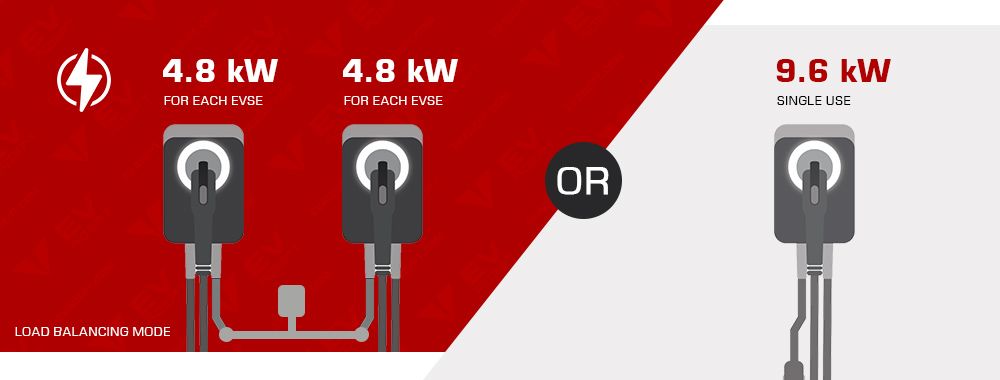
It provides more flexibility with the installation but in comparison with the previous method, it is much more expensive. The cost consists of the price of two charging stations and the cost of installing one more 240-volt outlet. In addition, it requires more complex wiring work.
To charge two EVs, you can purchase two typical 32A/7kW units and set them both up on a single 40-amp circuit. During simultaneous charging, the amperage will be reduced—these devices will share power and won’t overload the circuit. Charging time will be longer, and both cars take twice as long to charge, at least until one vehicle has finished charging. If just one EV is charging, it will get full power.
Of course, having two stations in the house has its benefits, but this will only make sense if installing a dual home station is not possible. Considering the fact that the charging time is longer, it will take from 8 to 12 hours to charge the electric vehicle, depending on battery capacity. On average, with 3 kW of power, around 10–14 miles of range per hour will be added.
The most popular chargers with load balancing include:
- Tesla Wall Connector. This is a hardwired 48-amp station that charges 11.5 kW. The device can charge an EV from any other brand by using the Tesla to J1772 adapter.
- Enel X JuiceBox EV Smart Charger. This device supports load balancing and is available in several amp versions. It can charge a Tesla with a Tesla to J1772 adapter.
Option 3: Two Chargers Connected to Separate Circuit Breakers
If you often have to charge your electric cars at home, connecting separate charging stations to different circuit breakers might be the best option. The main advantage is that no matter how many cars are charging at the same time, the EVs will receive maximum power. Accordingly, the charge time for each vehicle will be only about 4–6 hours. But this is the most expensive option since, in addition to the costs of stations, you need to purchase circuit breakers and hire an electrician.
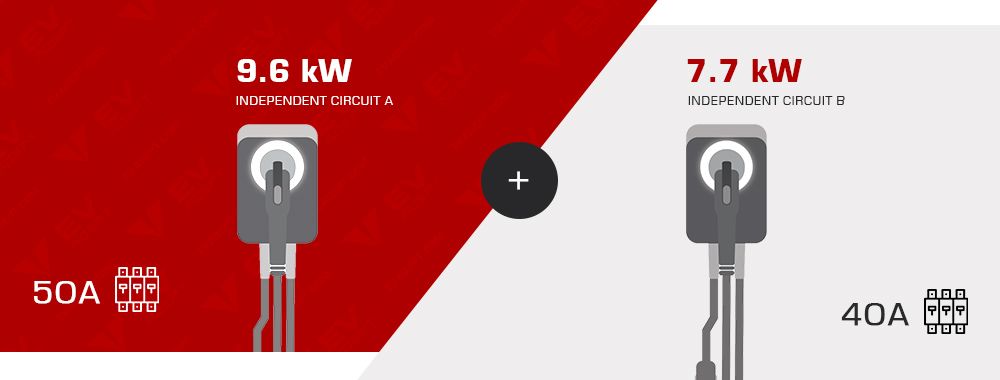
For maximum charging speed, each station is connected to a separate circuit breaker. This device protects equipment from aggressive temperatures and destruction in the case of a short circuit. The 30-amp point will require a 40-amp circuit breaker to be installed.
Installing separate charging stations requires some knowledge of home wiring and charge points installation. If you are not a qualified electrician, it is better to entrust this work to professionals.
There are the best home stations:
- ChargePoint Home Flex. This compact 50-amp station is available in plug-in or hardwired form. It connects to WiFi and has various extra features.
- Pulsar Plus from Wallbox. 40-amp station with smart functions like Google Home & Alexa. It is available in different connection types.
- EVoCharge EVSE. This 32-amp device charges for an additional estimated 25–35 miles of range per hour.
Option 4: A Level–2 Charging Station and a Level–1 charger supplied with the EV
If you don’t want to spend the money to buy several charging stations or a dual device, then the best option is to install just one Level-2 station and use a standard Level-1 charger.

The Level-1 device is the simplest type because it uses a basic home electrical current and plugs into a standard grounded outlet. It doesn’t require any special equipment for use—just take the cord and plug it into the outlet and the car. You don’t even need to buy it, as automakers provide a kit when you buy a car (there are exceptions, like owners of a Tesla or KIA EV6). So, the main advantage is cost savings because you do not need to spend money to buy an additional station and circuit breaker.
This option is great if one of the cars is a hybrid or its battery has a relatively small capacity. What’s more, on days when your family doesn’t need to drive much, you can just switch out the Level-2 charging point between both electric cars.
Speaking about the charging time, the usual Level-2 device has a power of 7.2 kW, which allows you to fully charge 100% of the electric car in 4–7 hours. If you have a terminal of 3.6 kW, then the car will charge two times longer. A Level-1 charger has a power of 1.4–1.9 kW, and a full charge of an empty EV battery can take around 24–35 hours. The device adds from four to six miles of battery range for every hour of charging.
If you have Tesla, there’s a hack: as every car comes with a Tesla mobile charger, you don’t need to install one more Level-2 device at all. Just buy a 240-volt NEMA 14-50 adapter for about $40, and the charger will be able to deliver up to 32 amps.
While a lot of stations are designed to be permanently installed in the garage or outside the home, it might be a good idea to choose a plug-in model. The installation cost is about the same, but having a portable terminal means that you can easily take it with you and plug it into the 240V circuit.
The best models of portable chargers include:
- Mustart TravelMaster. The device with the ability to connect to 120-v and 240-v. Also popular for travel.
- MEGEAR Skysword. NEMA 5-15 and 6-20 charger. Its affordable price made it the top seller in its class.
- BougeRV Level 2 Portable Electric Car Charger. The device delivers up to 32 amps and has an IP67 waterproof rating.
Option 5: Use a smart splitter for 2 charges and one outlet
The difference between the smart splitter and the others is that it can perform simultaneous limited power delivery to 2 chargers. Thus the splitter performs the load balancing function without overloading the grid and the breaker.
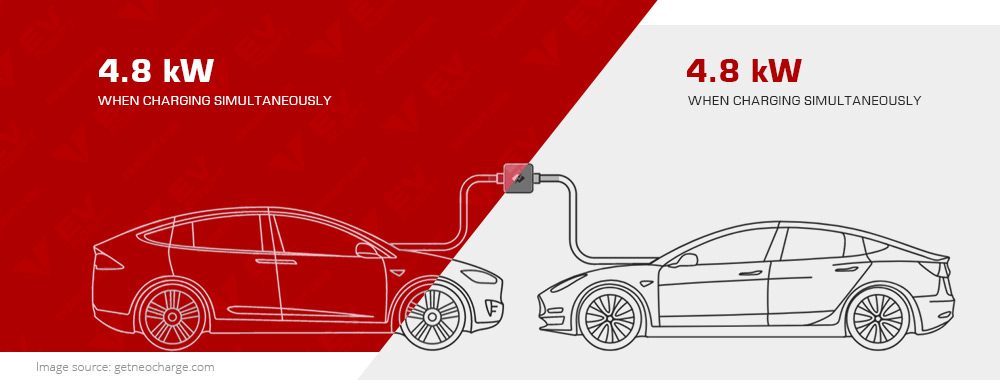
The advantage of this method will be found by owners of electric cars with access to only 1 outlet and who already have 2 chargers, optimally of Level 2. This method of charging two cars does not require an panel upgrade, and this is what attracts some buyers.
The disadvantage may be the risk of use in public parking lots, even community parking lots, due to the insecurity of the compact device against theft.
If the two chargers have different NEMA connectors, connecting them to the smart splitter will be a problem without an additional upgrade. NEMA 10-30, 14-30, 10-50, 14-50 splitters can be found more commonly.
Operation options can be either charging a pair of electric cars at the same time or sequentially when the conditions set in the mobile app are met.
If you don’t have two chargers, would it be more economical and practical to buy one Dual Charger (comes with 2 J1772 plug-ins) and plug it into that one outlet?
- $32999Prime
eligibleJul 9, 2025 6:15 AM - $19999Prime
eligibleJul 9, 2025 6:15 AM - $23999Prime
eligibleJul 9, 2025 6:15 AM - $32999Prime
eligibleJul 9, 2025 6:15 AM - Get a great dealJul 9, 2025 6:15 AM
- Get a great dealJul 9, 2025 6:15 AM
Option 6: Using a dumb splitter for 2 charges and one outlet (not recommended)
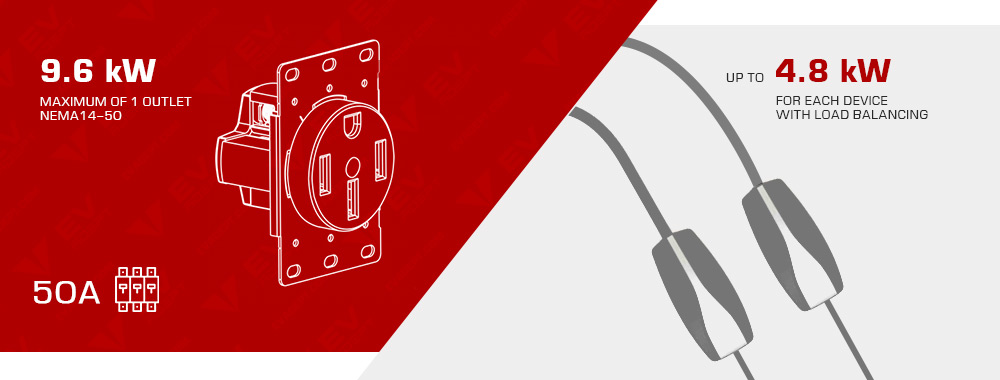
For which users would option #5 not work with an expensive smart adapter? For all the same electric car owners who already have 2 chargers available, but with load balancing.
Examples of such devices are JuiceBox 40, WallBox or TWC gen 2. The difference from method #2 is that there is only one available outlet.
The point is that the load balancing technology (aka Power Sharing) allows, in theory, to connect two EVSEs to one socket through a simple (non-smart) adapter and charge 2 EVs simultaneously.
The advantage of this method can only be the inexpensiveness of the splitter, compared to the smart splitter.
The first disadvantage is that, more often, these adapters have 2 identical female ports, so the plugs of the chargers must match more often than not. In the case of adaptable chargers like Tesla Mobile Connector or Audi Universal Charger, it is possible to upgrade them by buying an additional cable (adapter) with the right NEMA connector.
The second disadvantage is the risk that the load balancing technology more often works correctly only with the same devices, so there remains a high probability of overloading the network. If you are using a NEMA 14-50 (50A breaker, 40A socket and 9.6kW), several load balancing tests have noticed an underestimate of 4.0kW for identical devices instead of the theoretical 4.8kW (9.6/2=4.8).
Advanced users may argue that load balancing is unnecessary if you set the chargers (or the electric car settings) to low power consumption. This may or may not work. In the case of an unexpected network reboot, are you sure that EVSE won’t apply inflated defaults and overload the network? In addition to the disadvantage, this method is likely to be close in speed to a slower Level-1 charge, which will not suit all users.
In this way there are still risks of an incorrect connection, and it is suitable only for rare cases, so it is not recommended.
In addition, do not confuse such a splitter-adapter with switches, which cannot supply current to two sockets simultaneously.
- $15599Prime
eligibleJul 9, 2025 6:15 AM - $6999Prime
eligibleJul 9, 2025 6:15 AM - $3699Prime
eligibleJul 9, 2025 6:15 AM - $7899Prime
eligibleJul 9, 2025 6:15 AM - $2999Prime
eligibleJul 9, 2025 6:15 AM - Get a great dealJul 9, 2025 6:15 AM
How is power distributed in dual chargers between electric cars being charged at the same time?
When testing the installed equipment, the EVadept team noticed that a 40-amp EVSE was outputting only 32 amps to an electric car. In what situations could this happen?
- If you plug one electric car into the Dual Charger (40A), it can reach 40.
- If you plug in two cars and they are charging at the same time, each can reach up to 20A (half of 40A).
- If you plug in two cars but only one is charging, it will only have 32A available and 8A reserved for the second uncharged car. To get to 40, you have to disconnect the second electric car.
The principles above work on most modern double chargers, but use the manual to understand the conditions for how your unit behaves.
At this point, double EV chargers generally do not have smart features or the ability to control via a mobile app. All conditions are hardwired into the device itself and cannot be changed. The inability to set your own conditions is the disadvantage of this type of device. An alternative as a more manageable connection is discussed in option #2 and option #3.
A Final Note
We have considered all the options to charge two electric cars at the same time at home, and depending on your budget and needs, you can choose the most suitable. The cheapest option would be to install a Level-2 EVSE and use a Level-1 charger. If your family drives far or often, then you can also consider the installation of two chargers connected to different circuit breakers, which will help to minimize the charging time of cars. In most cases, the best option would be to buy a dual EV charging station or installation of two devices connected to one circuit.
FAQ
What is a dual EV charger?
A 32-80 Amp Level-2 plug-in or hardwired station, which can charge two electric cars with one station on a shared circuit. We’ve reviewed the top dual chargers and selected our top choices.
Are you able to charge two EVs simultaneously?
Buy a Dual Charger. It divides the electricity between the two EVs. Each receives up to 20 Amps while charging at once, and 40 Amps for charging one vehicle. We’ve compared and shown you the best chargers for 2 EVs.
How can you charge two electric cars at once?
Some new EVs now come standard with 240-volt portable charger. You can also install two outlets (typically a NEMA 14-50), while still ensuring you have enough amperage to run both of them simultaneously. Plug in either one or both of your portable chargers as necessary. A more popular solution is the 2-in-1 EVSE. Compare them here.
How can you charge multiple Teslas at once?
One of the ways is the Wall Connector, which is the fastest method to charge at home. Multiple Wall Connectors can be connected to share the power and charge your household for two or more Tesla cars. The Wall Connector allows you to charge your vehicle at home quickly. Read about other solutions in this article.
Are you allowed to have 2 Tesla Chargers in your home?
Both your Teslas can be charged simultaneously by either setting the current limit or charging one after another… You will need to monitor your Teslas to know when they are fully charged. Once you have done that, go to your garage to switch the charger to your second Tesla. Read about other solutions here.
Is it possible to charge 2 Tesla cars with a Tesla wall charger?
Power sharing is a feature that allows up to several Gen3 Wall Connectors to power multiple vehicles. If you are considering one device to charge 2 cars, take a look at our review.
What is a dual motor Tesla?
The Tesla Model S, manufactured from 2012–2016, had the option of a dual motor. These models are equipped with an optional charging module and can be retrofitted and would double the charging capacity to 22kW (instead 11 kW). An EV like this would get maximum power from the TWC of 80A.
What if you want to charge two EVs simultaneously?
There are several options. Install two chargers or buy a twin EV charger. A dual-socket charging point is available in our review.
Are two cars allowed to use the same charger?
Yes, if it is a special device. This can lead to vehicles being charged at different rates, and it is possible that one charge point will prevail over another. Two chargers mean half of the speed. It means that you can charge up to two vehicles simultaneously. All other ways are described here.
How many electric cars can you charge at your home?
It all depends on the architecture of the electrical grid and the installed breakers. It is possible to connect several chargers to the network, but you need to understand what kind of load the socket and breaker are designed for. This is what our review is about.
What is load balancing for EV charging?
The power distribution of electric car charging load balancing refers to a power distribution across multiple vehicles. A high-capacity EV charger station will, for example, distribute power to all charging vehicles. Multiple vehicles can be charged at the same EV charger station. These and other principles are explained in this article.
What’s the purpose of dynamic load managing?
Dynamic Load Management helps you to avoid costly power capacity upgrades when still installing the required number of chargers. It distributes available power dynamically and effectively. It makes sure that the grid does not get overloaded. Each EV is also charged efficiently.
How does load balancing work in EVs?
Load Balancing reduces overcapacity by evenly distributing available capacity across all charging ports in a given area. It is an essential smart charging feature for anyone who operates multiple charging ports in a limited area. Read about these and other features of the best chargers in the current review.
What does levelling mean for an electric car?
Levelling, also sometimes referred to as dynamic load balance allows you to safely balance energy consumption between your electric car charging station and other appliances on the site so that your car charges in the most efficient way.
What is a dynamic load balancing charger?
Dynamic load balancing is used for EV smart charging. It analyzes the available power based on energy consumption at the property, and then distributes that energy to all active charging points. Dynamic load balancing chargers can be evaluated here.
What is Power Sharing for EV charging?
Power Sharing, also sometimes referred to as load balancing, is a method of optimizing EV charging properties. First, electricity is evenly distributed to all EVs simultaneously. Second, charging occurs at a full rate whenever there’s enough capacity.
What is smart charging an EV?
Smart EV charging, also known as intelligent charging, refers to a system in which an electric vehicle and a charging device share data connections. The charging device also shares data with a charging operator.
Can two Chevy Bolts be charged simultaneously?
Yes. Rapid chargers considered here can charge multiple vehicles simultaneously. Although it will offer a slower rate than one vehicle.
What is the best way to charge two electric cars?
A Dual EV charger is recommended if you are certain you will need more than one home EV charging station to charge two cars. Reviewed here, dual EVSEs allow you to “daisy-chain” up to several chargers that will equally share the power of their electrical circuit.
Can ClipperCreek charge two cars simultaneously?
ClipperCreek, Grizzl-E, or another of the latest charging equipment allow for simultaneous charging of up to two vehicles. See a comparison of devices in this article.
Can you have 2 EV chargers at home?
Yes, but you might face limitations on available power for multiple Level-2 devices. From the EVadept team’s practice in new homes, the panel has up to 200A, which allows you to plug in 2 EVSEs, but often customers choose one device for two EVs. These are the so-called Dual chargers, models of which you can get acquainted with in this review.
Can you charge 2 electric cars at home?
For slow charging Level-1, you can often find a place to connect two devices, which is not the case for Level-2. If you want to learn about connection options for 2 EVs, check out this expert review here.
How fast does a Dual Charger charge?
The typical model Dual Charger installed by the EVadept team is a 40A. The unit is capable of outputting 20A to each vehicle. For different cars you can calculate the charging speed in our calculator.
How long does it take to charge a double EV charger?
The EVSE dual EV chargers installed by EVadept are usually connected to a 50A breaker and are able to deliver a total of 40A, and if you connect two EVs at the same time, up to 20A for each car. Find model options in this expert review.
What’s the best way to simultaneously charge two electric cars?
In this review, Mike Becker highlights up to 6 ways to connect for different situations. One of the easier ones is to use the Dual EV Charger. Review proven models and other options in this article.
Which is the safest way to charge two electric cars?
The evadept.com team has noticed problems with customers using different splitters for the same outlet when installing EVSE. The safest way may be to hardwire the devices in one of several ways described in this professional guide.
What is a multi EV charger?
As Mike Becker describes in his book, it is a type of charger with two or more plug-ins to connect multiple EVs at the same time. Examples of multiple EV chargers for the home are described here at evadept.com.
What is a Twin EV charger?
This is what EV adept customers call a dual EV charger, double EV charger or two-car EV charger. It is capable of charging two cars at the same time. It can be FCDC (Level-3) or Level-2, examples of which are presented in this review.
What is the principle behind charging two electric cars using a Dual Charger at home?
As Mike Becker points out in this review, if 2 electric cars are plugged in and one of them is charged, the second EVSE does not give full power to the second electric car. For an EVSE 40A, 8A are usually reserved for the connected but not charged car. More details here.
What is the maximum power each electric car will get when charging two cars at the same time?
There will be different conditions for Level-3. For a Level-2, the power will be limited to the connection option chosen (typically 20A), which is described in more detail here.
How much power is lost when charging 2 EVs simultaneously at home?
Mike Becker writes in this article that it will take exactly the same amount of power to charge two EVs at home as you would charge them alternately. Use the calculator from evadept.com to calculate.
Are there Dual EV chargers for Tesla?
When it comes to home EVSE models, there are no dual units available with the Tesla Connector (NACS). However, the models in this review are fully capable of charging two Teslas at the same time using the adapter that comes with each Tesla.
Is the Grizzl-E Duo compatible with other electric vehicles?
The EVadept team has installed a large number of Grizzl-Es and all have been compatible with customer vehicles. When choosing a two-car EV charger, consider the differences between the other models in terms of power and cable lengths, which we show here.
How long will it take to charge 2 electric cars from one outlet?
This will be influenced by the amperage of the outlet, battery capacity and discharged battery, and EVSE type. For example, it would take 16 hours to fully charge two Tesla M3 SRs with discharged batteries from a NEMA 14-50. Take a look at an overview of all the options for charging two electric cars.
How does the ClipperCreak Dual charger work?
It splits the maximum power intended for one electric car into two when connected to charge a second car. Our comparison chart has different models in terms of power.
How does the Grizzl-E Duo work?
It will deliver up to 40A when connected to one electric car and will work like a regular single charger. If you connect a second car for simultaneous charging, the device will work as a two-car EV charger and will give up to 20A for each car. Other dual models are in our comparison table.
How much does a dual port EV charger cost?
In some models, the price for a dual charger can be as much as two independent high-end EVSE chargers. The savings are often to avoid installation costs and panel upgrades. For top-rated models with prices, check out our guide.
What type of wall outlet is required to use a dual charger?
Usually it’s NEMA 14-50. Sometimes the EVaadept team will install a hardwired connection for customers with higher security requirements.
How much power can a two car EV charger supply?
When it comes to Dual EVSE for home use, you’ll see 32A and 40A in our comparison chart of top-rated devices.
Can a Twin EV charger be used with existing wiring and outlets at home?
Typically there are 2 types of connections for a dual port EV charger. The first is a NEMA 14-50 outlet (must be available). The second option is hardwired, requiring the services of an electrician. Check out the model comparison chart prepared by the EVadept team.
Does a Dual Home EVSE require additional installation or setup?
If you want to charge two EVs from one charger, it can be connected without the services of an electrician if you have a 240v outlet. In Mike Becker’s review, take a look at the tested models and their types of outlets.
How easy is it to install a Dual Plugin EV Charger?
If you want to charge 2 electric cars at home, the ease of connection depends on the Dual charging station model you choose. If you choose the best plug-in EV charger for two cars from our model review, you can get by without an electrician.
Does ClipperCreak Duos have an app for monitoring?
There are generally no smart devices among Dual charges models. The differences presented in our comparison are in amps, type of connection, and more…
Do Double EV chargers have any smart features?
Does the Grizzl-E Duo have additional features or functions?
What type of plug is used for a typical Dual EV Charger at home?
In North America, it is the J1772 plug. However, if you want to charge 2 Teslas at the same time, it’s quite easy with an adapter. All that remains is to choose from our review the model with the right power for you.
How much energy does a Dual EV charger draw from the wall outlet?
The most popular models among evadept.com customers are ClipperCreek HCS-D40 (up to 7.7 kW total) and Grizzl-E Duo (up to 9.6 kW total). These and other models are compared in this review.
Does a ClipperCreek HCS-D50 require regular maintenance?
Proper operation of the unit, following the general rules of use from the manufacturer, is sufficient. Just like the other tested dual port ev chargers in our comparison review, this one has a 3 year warranty.
How does Dual EV Charging compare to other charging methods?
The main feature of this method for the home is that there is only one rather than two charging stations. The current review from Mike Becker is about finding the right way to charge two electric cars at the same time.
How large is a Dual Charger as Grizzl-E or ClipperCreak?
The size of the main unit is usually 15% larger than a single-EVSE. The main extra volume of a double EV charger by having an extra cable with a plug for a second electric car. The dimensions are shown in the comparison table.
What chargers support multiple charging modes at home?
Grizzl-E and ClipperCreak are popular among EVadept customers. How they differ is explained in this review by Mike.
Is there a Tesla Dual EV charger as one device for two EVs?
There is no such device from Tesla, but other models reviewed here may work for charging two Tesla vehicles (with an adapter).
What are the benefits of the Dual Charging Station?
The Dual Charging Station provides convenience and efficiency for EV owners, as it saves time and money by charging two vehicles at once. It also allows for easy and safe installation via 240v socket without electrician services.
Contents
- 1 Option 1: Dual Charging Station
- 2 Comparison chart of dual home EVSEs
- 3 Option 2: Two Chargers Connected to One Circuit
- 4 Option 3: Two Chargers Connected to Separate Circuit Breakers
- 5 Option 4: A Level–2 Charging Station and a Level–1 charger supplied with the EV
- 6 Option 5: Use a smart splitter for 2 charges and one outlet
- 7 Option 6: Using a dumb splitter for 2 charges and one outlet (not recommended)
- 8 How is power distributed in dual chargers between electric cars being charged at the same time?
- 9 A Final Note
- 10 FAQ
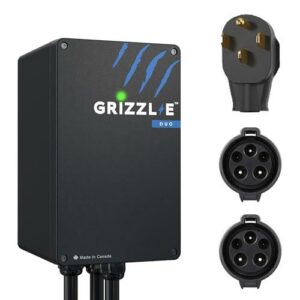

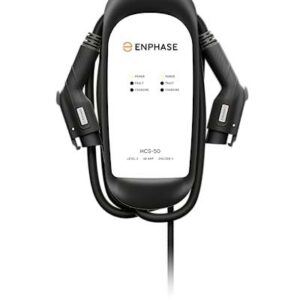
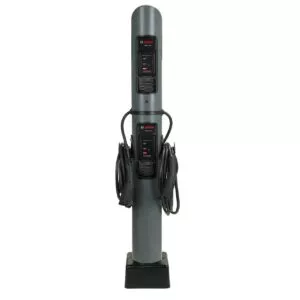
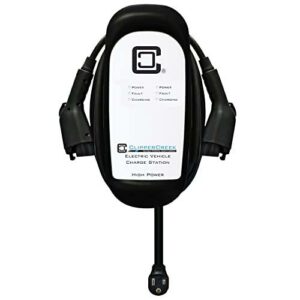
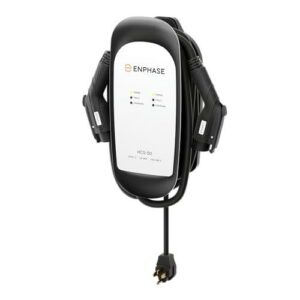

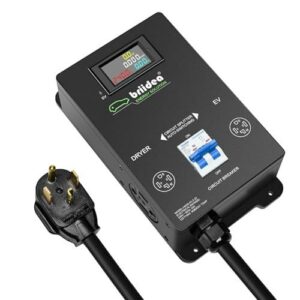
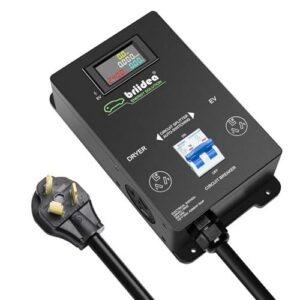
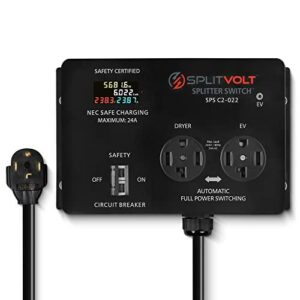
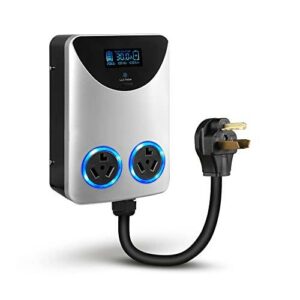
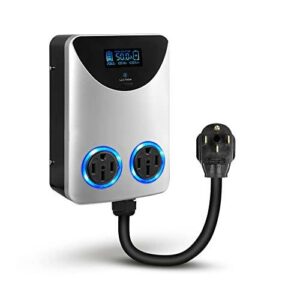
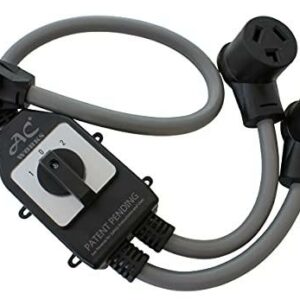
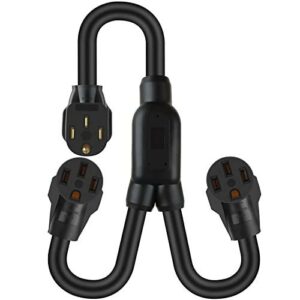
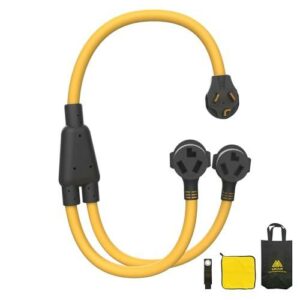

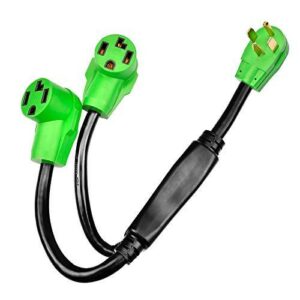


We’ve had our Bosch multi EV charger for about six months now, and we absolutely love it! It’s so easy to use and it works perfectly.
We would definitely recommend the Grizzle to anyone looking for a good home twin EV charger. We’ve had our Grizzle Dual Home EV charger for about a year now, and we absolutely love it! It’s so easy to use and it works perfectly.
I need to split a 40amp 240v feed into two feeds for two EV chargers. Each charger is capable of running at 32 amps, but when two are connected they will switch to 16 amps. Each output feed must have a circuit breaker. Have you ever had to solve a similar problem?
There is nothing wrong with having two 40-amp receptacles connected to one circuit breaker.
We love our grizzle for 2 EVs charger! It’s so easy to use and it works perfectly. We would definitely recommend it to anyone looking for a good home EV charger.
Do I need load balancing to charge my EVs?
Load balancing is even more important for larger installations that have multiple EV chargers. This will optimize the EV charging network, distribute power equally across all charge points and ensure that EVs can be charged as quickly and efficiently as possible.
The ClipperCreek EV charger for 2 cars is one of the best home EV chargers on the market. It’s easy to install and use, and it’s very efficient. We’ve been using it for about a year now, and it has never let us down.
How can i charge two electric cars at my home?
Dual home charging stations allow two cars to be charged simultaneously. This simple method will ensure that both cars are fully charged each morning. You could also ask your installer to install two chargers on the same circuit…
How can I find out if my Tesla has dual charging?
The lightning bolt will appear on the display. Dual chargers are available if the amps reach 80 amps.
I’m looking for advice on the best home charging options for a dual EV household. We currently have two cars and both are electric. We’re looking for a reliable and cost-effective way to charge both cars at the same time. Any advice would be greatly appreciated!
The best way for me is the Grizzl-E Duo with 4.8kW for each EV or 9.6 for one
Look at the comparison above. Then just choose the path that’s right for you. Some people have panel limits and one device works for them, and some can hook up two EVSEs, as described above.
I would recommend getting two Level 2 chargers for your home. This way you can charge both cars simultaneously, and it will be much quicker than charging with a Level 1 charger. You might also want to look into a smart charger that can be managed from your phone.
This is a great offer from Grizzl-E. I’ve been considering getting an EVSE for a while, and this is a food incentive to finally take the plunge.
i’m not sure if the clippercreek hcs dual charger is worth the cost. i’d like to hear more feedback from other users before i make a decision
As an owner of two EVs, I was excited to learn about the possibility of charging both at the same time with the multi-EV household charge. It’s a great way to save time and energy, and I’m sure this will become more common among EV owners in the future. I’m looking forward to seeing how this technology develops and evolves over time.
I just installed Grizzly Duo in my home. Now I can charge two electric cars at the same time, making life so much easier. Thank you all for the advice and Mike for the review
The HCS-50 seems like an excellent choice for anyone looking for a powerful and sophisticated twin charger. The bonus of getting paid to trade up is the icing on the cake.
Do you mean ClipperCreek HCS-D50P? The bonuses ran out a long time ago. That’s why I chose another brand.
I recently purchased two Tesla’s and I’m wondering if anyone has experience charging two of them at the same time? Is there any special adapter I need to do this?
The J1772 to Tesla (NACS) adapter is only needed to use the charging stations with Tesla. If you are looking for a splitter adapter for two electric cars, you just need to buy a charger with two plug-ins. Look at the examples in the comparison table at the top of the page. Any twin EV charger will work great with the Tesla with the adapter you probably have in your trunk.
i’ve been charging both of my teslas with a single charger and it seems to be working fine
I don’t like moving the plug from one car to another at night
This is a great way to encourage more people to drive electric vehicles. The dual EV charger from ClipperCreek is a great option for those looking for an efficient and reliable charging station.
I have two cars. Kia EV6 & Hyundai IONIQ 5. I charge one with a portable L1 charger. For the second car I just bought the JuiceBox Pro 40 and it’s absolutely amazing. I love the sleek design and it charges my car really quickly.
I’m faced with a choice right now. But it seems obvious to me that I should buy a dual charger Grizzl-e, especially since it is cheaper than the JuiceBox Pro 40. It’ll be ideal for my Revian R1T.
I’m curious to know if anyone has experience charging two Chevys at the same time. What are the best techniques or products to use in order to achieve this?
The ClipperCreek HCS-D50P is great. I’ve been using it for a few months now and it’s been working perfectly for my 2 EVs. It’s really powerful and I feel like it’ll last me a long time.
I just got a new Mach-E, and CC D50P charger looks like the perfect way to keep it fully charged
The Grizzle Duo is a must-have for any EV owner. It’s really fast and the user interface is really simple to charge one or two cars.
I recently purchased two VW ID.4 vehicles and I’m wondering what the best way is to charge both of them at the same time. Is there a way to wire them together and have them draw from the same power source?
Any dual charging station from this review is a great solution for those of us who have multiple electric vehicles.
The Clippercreek multi charging station is an excellent innovation and definitely a must-have for anyone with an electric vehicle.
I’ve been looking into getting a dual charger to charge both of my Teslas at the same time. Does anyone have any recommendations?
I love the idea of being able to charge two electric vehicles at once with the load balancing. Very convenient.
Does anyone have advice for finding the most cost-effective home charging station for two EVs (BMW i4 and Chevy Bolt)?
If you have an overnight power rate, you need to have time to charge during that time. Calculate. And consider one multi EV charger or two independent EVSEs.
What are the best home charging options for a dual EV household?
All the options are written in this review. There’s really nothing to add. For Tesla M3 and Revian R1S I use the Grizzly duo
I’ve had the Grizzl-E Duo for about 6 months now, and it’s been a game-changer for my wife and me. We both have EVs, and the simultaneous charging feature is a lifesaver. The only downside? The initial setup was a bit tricky, but once it was up and running, it’s been smooth sailing. Anyone else using this charger? Thoughts?
I’ve been using the Grizzl-E Duo for a year now. Totally agree with you on the setup part. But it’s been reliable since then. Do you use any specific app to monitor the charging?
I’m considering the ClipperCreek HCS-D40 for my home. But I’m a bit concerned about the split charging when two EVs are connected. Does it significantly slow down the charging process?
I’ve had the HCS-D40 for a while. When both cars are charging, it does split the power, but I haven’t noticed a drastic slowdown. It’s still pretty efficient.
For those new to dual EV chargers, here’s a quick guide: 1. Always ensure your EVs are compatible with the charger. 2. For optimal charging, try to stagger your charging times if possible. 3. Regularly inspect your charger for any wear and tear. 4. Keep the charging area free from obstructions. Hope this helps!
Hey folks, I’m on a tight budget but need a dual EV charger for my home. Any recommendations that won’t break the bank?
I’d suggest looking into the EV Charge Solutions Dual Voltage. It’s not as fancy as some others, but it’s been reliable for me and didn’t cost an arm and a leg.
I’ve been facing an issue with my ChargePoint CT4000. Sometimes, one of the ports doesn’t recognize my car. Tried resetting, but no luck. Anyone else faced this?
I’ve been torn between the Grizzl-E Duo and the ClipperCreek HCS-D40. Both seem great, but I’m leaning towards the Grizzl-E because of its compatibility with all North American EVs. Thoughts?
A tip for new dual charger users: If you’re charging two cars, try to charge one during off-peak hours (like overnight) and the other during the day. This way, you can maximize the power to each car and reduce charging time.
Heads up! ChargePoint just released a new software update for the CT4000. It’s supposed to improve connectivity and fix some minor bugs. Make sure to update!
Anyone interested in a group buy for the ClipperCreek HCS-D40? I’ve found a dealer who’s willing to give a discount if we buy in bulk. Let me know!
Just read that there’s a recall on certain EV Charge Solutions models due to a potential fault. If you’re using one, better check if yours is affected. Stay safe!